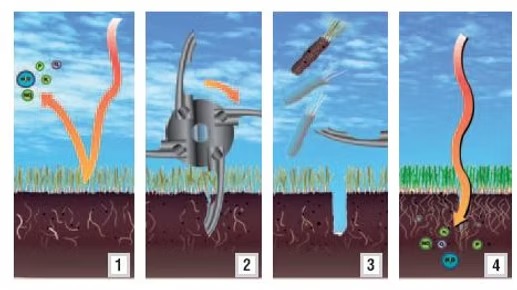Aeration
Tax sale is not included in prices. 8.25% wil be included on invoice total.
A Breath of Fresh Air
Aeration is an important part of a lawn care program. Technically speaking, aeration is the naturally occurring process of air exchange between the soil and the surrounding atmosphere. Practically speaking, aeration is the process of mechanically removing small plugs of thatch and soil from the lawn to improve natural soil aeration.

Soil compaction is a frequent cause of turf deterioration. Caused by lawn traffic such as walking and mowing. Compaction is greatest in the top 2-3” of the soil. In compacted soil, dirt particles are forced together reducing the area where roots can grow. Aeration remove cores of turf, relieves compacted soil by improving the exchange of water and critical nutrients between the atmosphere and the grass’ roots.
Lawns that receive regular aeration will be greener, easier to maintain and suffer from fewer pest problems and diseases.
The Benefits Of Aeration Are Numerous
- Improves the exchange between the soil and atmosphere.
- Increases water intake.
- Reduces water runoff and puddling.
- Improves fertilizer uptake and use.
- Stimulates root development.
- Reduces soil compaction.
- Increases the tolerance to heat and drought stress.
- Improves resiliency and cushioning.
- Enhances thatch breakdown.
Why is aeration necessary?
In most home lawns, the natural soil has been seriously disturbed by the building process. Fertile topsoil may have been removed or buried during excavation of the basement or footings, leaving subsoil that is more compact, higher in clay content and less desirable for healthy lawn growth. These lawns need aeration to improve the depth and extent of turfgrass rooting and to improve fertilizer and water use.
Intensively used lawns are exposed to stress from traffic. Walking playing and mowing are forms of traffic that compact soil and stress lawns. Raindrops and irrigation increase soil density by compacting soil particles and reducing large air spaces where roots may readily grow.
Most home lawns are subject to thatch accumulation. If thatch is left unmanaged, it can lead to serious maintenance and pest problems. Core aeration reduces thatch accumulation, minimizes its buildup and modifies its makeup by incorporating soil into the thatch. As soil is combined with the thatch debris, soil organisms are better able to break down the thatch and reduce its accumulation.
